
This is the order of battle for the Guadalcanal Campaign, called Operation Watchtower, the first major Allied offensive in the Pacific Theater of Operations in World War II. The campaign lasted from the initial American landings on 7 August 1942 until the final Japanese evacuation on 9 February 1943, a period of six months, far longer than was expected by Allied planners.
The 7 August landings on Guadalcanal itself and Tulagi across Savo Sound (the site of a Japanese seaplane base) were carried out by US Marines under the command of Major General Alexander A. Vandegrift. These were followed by units of the Naval Construction Battalions, known as CB's or Seabees.
Forces of the US Army began arriving to relieve the exhausted Marines on 13 October. On 8 December Vandegrift was replaced by Major General Alexander M. Patch, US Army, who was named commander of the XIV Army Corps on 2 January 1943. Patch declared the island secure on 9 February.
The high command of the Imperial Japanese Army did not take initially the Allied effort on Guadalcanal seriously and committed units piecemeal throughout the fall of 1942. Over the course of the campaign, the Japanese subjected two entire infantry divisions to massive attrition on the island.
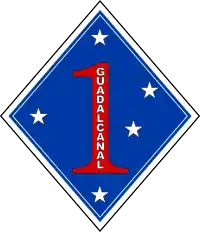
The 1st Marine Division's struggle to take Guadalcanal achieved legendary status: the heat and mud, the malaria and dysentery, the giant tropical insects and the fanatical, often suicidal, resistance of the Japanese combined to create an immense amount of sheer suffering. Today, the unit's insignia features the word "Guadalcanal" superimposed on a large red numeral 1. Three future commandants of the Marine Corps fought on "The Canal": Alexander A. Vandegrift, Clifton B. Cates and Lemuel C. Shepherd. Vandegrift was awarded the Medal of Honor the following year in recognition of his courage and extraordinary leadership during the Corps's four-month struggle.
.jpg.webp)
Why does the mere mention of the southwest Pacific cause the men who fought there to shudder? Why does so genteel an author as Herman Wouk, whipped into a white-lipped rage at the mere thought of Guadalcanal, write that it "was and remains 'that fucking island'"? Why was combat there considered — correctly – worse than Stalingrad?
— William Manchester, Goodbye, Darkness: A Memoir of the Pacific War (1980), p. 79
In addition to the action on the ground, the United States Navy and Imperial Japanese Navy fought several vicious and costly surface engagements at night in the waters of Savo Sound. Two nights after the initial landings, the US Navy experienced the worst open-water defeat in its history at the Battle of Savo Island. By the time the Japanese had given up on Guadalcanal, they had lost 2 battleships, 2 heavy cruisers and 7 destroyers; Allied losses included 5 heavy cruisers (one of which was Australian), 2 light cruisers and a destroyer. Each side had an admiral killed in combat. After the war, the area was renamed Ironbottom Sound in reference to the number of ships sunk there.
United States
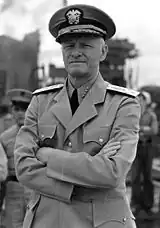




Theater command
The roles of Commander in Chief, Pacific Ocean Areas (CINCPOA) and Commander in Chief, U.S. Pacific Fleet (CINCPAC), were both exercised by Admiral Chester W. Nimitz from his headquarters at Pearl Harbor, Hawaii.
Since the Solomons lie in the Southern Pacific, the landings of 7 August 1942 on Guadalcanal were the responsibility of the South Pacific Fleet, led by Vice Admiral Robert L. Ghormley from his headquarters at Nouméa, New Caledonia.[1] Adm. Ghormley's pessimism, inadequate staff work and unwillingness to visit the front led Adm. Nimitz to replace him with the much more aggressive and hands-on Vice Admiral William F. Halsey on 18 October 1942.[2]
Operational command
Operational command of the invasion was assigned to Vice Admiral Frank Jack Fletcher. He also had direct command of the covering force, designated Task Force 61, where he flew his flag aboard fleet carrier Saratoga. The amphibious forces, Task Force 62, were led by Rear Admiral Richmond Kelly Turner aboard attack transport McCawley.
Bitter disputes between Vice Adm. Fletcher and Rear Adm. Turner arose during both the planning and execution of the invasion. At issue was how long Fletcher's aircraft carriers would stay in the vicinity of Guadalcanal to provide air cover for Turner's support vessels in Savo Sound. The matter came to a head on D+1 (8 August), after two days of assaults by bombers from the Japanese base at Rabaul. These attacks convinced Fletcher that his crucial aircraft carriers could not be risked in the waters of the Solomons any longer and his task force departed the area that evening. Unsettled by the removal of air cover and rattled on the morning of D+2 by the discovery that his cruiser screen had been decimated at the Battle of Savo Island, Turner ordered his vulnerable, and still half-full, cargo ships back to Nouméa around sundown 9 August. The Marine Corps forces ashore were thus left without air cover or the planned level of food and ammunition. This suboptimal outcome was at least partially attributable to the decision to vest both overall mission command and carrier task force command in the same individual (Vice Adm. Fletcher).
Marine forces
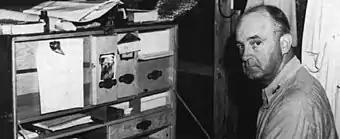




The D-Day (7 August) landings on Guadalcanal were carried out by the 1st and 3rd Battalions/5th Marines at 0910 hours, followed by the 1st Marines at 0930. Landings on the Florida Islands across Savo Sound were carried out earlier that morning by the 2nd Battalion/5th Marines, the 1st Parachute Battalion, and the 1st Marine Raider Battalion.[3] The 7th Marines and 1st Battalion/11th Marines arrived 18 September. The division began withdrawal from the island 12 December.
![]() 1st Marine Division
1st Marine Division
Major General Alexander A. Vandegrift[lower-alpha 1]
Asst. Div. Cmdr.: Brigadier General William H. Rupertus[lower-alpha 2]
- Division staff
- Chief of staff: Col. William C. James (to 24 Sep)[lower-alpha 3]; Col. Gerald C. Thomas[lower-alpha 4]
- Asst. CoS for Personnel (D-1): Col. Robert C. Kilmartin Jr.
- Asst. CoS for Intelligence (D-2): Lt. Col. Frank B. Goettge (to 12 Aug)[lower-alpha 5]; Lt. Col. Edmund J. Buckley
- Asst. CoS for Operations (D-3): Lt. Col. Gerald C. Thomas (to 24 Sep); Lt. Col. Merrill B. Twining
- Asst. CoS for Logistics (D-4): Lt. Col. Randolph M. Pate
 1st Marine Regiment
1st Marine Regiment
- Colonel Clifton B. Cates[lower-alpha 6]
- Exec. ofc.: Lt. Col. Julian N. Frisbie (to 23 Sep); Lt. Col. Edwin A. Pollock
- 1st Battalion: Lt. Col. Leonard B. Cresswell
- 2nd Battalion: Lt. Col. Edwin A. Pollock (to 23 Sep); Lt. Col. William W. Stickney
- 3rd Battalion: Lt. Col. William N. McKelvy Jr.
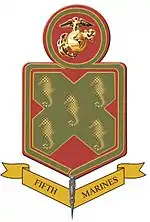 5th Marine Regiment
5th Marine Regiment
- Colonel Leroy P. Hunt (to 21 Sep)[lower-alpha 7][lower-alpha 8] ; Colonel Merritt A. Edson[lower-alpha 9]
- Exec. ofc.: Col. William J. Whaling (to 25 Sep); Lt. Col. Walker A. Reaves (to 12 Oct); Lt. Col. William S. Fellers
- 1st Battalion: Lt. Col. William E. Maxwell (to 30 Aug)[lower-alpha 10]; Maj. Donald W. Fuller (to 13 Oct); Maj. William K. Enright
- 2nd Battalion: Lt. Col. Harold E. Rosecrans (to 11 Sep); Capt. Joseph J. Dudkowski (1-17, 25-30 Sep); Lt. Col. Walker A. Reaves (18-24 Sep); Maj. David S. McDougal (1-8 Oct); Maj. William J. Piper (8-11 Oct); Maj. Lewis W. Walt
- 3rd Battalion: Lt. Col. Frederick C. Biebush (to 22 Sep); Maj. Robert O. Bowen
 7th Marine Regiment
7th Marine Regiment
- Colonel James W. Webb (to 20 Sep)[lower-alpha 11]; Colonel Amor L. Sims
- Exec. ofc.: Col. Amor L. Sims (to 20 Sep); Lt. Col. Julian N. Frisbie
- 1st Battalion: Lt. Col. Lewis B. "Chesty" Puller[lower-alpha 12]
- 2nd Battalion: Lt. Col. Herman H. "Hard-Headed" Hanneken[lower-alpha 13]
- 3rd Battalion: Lt. Col. Edwin J. Farrell (to 24 Sep); Lt. Col. William R. Williams
 11th Marine Regiment (Artillery)
11th Marine Regiment (Artillery)
- Colonel Pedro del Valle[lower-alpha 14]
- Exec. ofc.: Lt. Col. John A. Bemis (to 17 Oct); Lt. Col. Robert B. Luckey (to 28 Nov)[lower-alpha 15]; Lt. Col. Thomas B. Hughes
- 1st Battalion: Lt. Col. Joseph R. Knowlan (to 19 Oct); Lt. Col. Manley L. Curry (to 28 Nov); Lt. Col. Donovan D. Sult (to 2 Dec)
- 2nd Battalion: Lt. Col. Edward G. Hagen (to 14 Sep); Maj. Forest C. Thompson
- 3rd Battalion: Lt. Col. James J. Keating
- 4th Battalion: Lt. Col. Melvin E. Fuller (to 28 Oct; from 7 Dec); Maj. Carl G.F. Korn (28-31 Oct); Capt. Albert H. Potter (to 6 Dec)
- 5th Battalion: Lt. Col. E. Hayden Price (to 18 Oct); Maj. Noah P. Wood, Jr.
- Other Marine units
- 3rd Defense Battalion (landed 7 Aug): Col. Robert H. Pepper
- Executive officer: Lt. Col. Harold C. Roberts
- Operations officer: Maj. Samuel G. Taxis
- 1st Parachute Battalion: Maj. Charles A. Miller (to 18 Sep); Capt. Harry Torgerson (19-26 Sep); Maj. Robert H. Williams (from 27 Sep)
- 1st Raider Battalion: Col. Merritt A. Edson (to 21 Sep); Lt. Col. Samuel B. Griffith (22-27 Sep)
- 1st Amphibian Tractor Battalion: Lt. Col. Walter W. Barr
- 1st Aviation Engineer Battalion: Maj. Thomas F. Riley
- 1st Pioneer Battalion: Maj. James G. Frazer (to 25 Oct); Maj. Henry H. Crockett
- 1st Medical Battalion: Cmdr. Don S. Knowlton, USN
- 1st Special Weapons Battalion: Maj. Robert B. Luckey (to 6 Oct); Maj. Richard W. Wallace
- 1st Tank Battalion: Maj. Harvey S. Walseth
- 3rd Defense Battalion (landed 7 Aug): Col. Robert H. Pepper

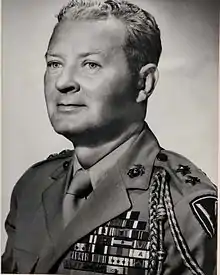

![]() 2nd Marine Division
2nd Marine Division
Brigadier General Alphonse DeCarre
The 2nd Marines reinforced by the 3rd Battalion/10th Marines were part of the initial 7 August landings. The reinforced 8th Marines landed on 2 November and the reinforced 6th Marines on 4 January 1943.
- Division staff
- Asst. to commanding general: Col. Leo D. Hermle[lower-alpha 16]
- Chief of staff: Col. George F. Stockes
- Asst. CoS for Personnel (D-1): Maj. Lawrence C. Hays Jr.
- Asst. CoS for Intelligence (D-2): Maj. Thomas J. Colley
- Asst. CoS for Operations (D-3): Lt. Col. John H. Coffman
- Asst. CoS for Logistics (D-4): Maj. George N. Carroll
- Division special troops: Col. Maurice G. Holmes
 2nd Marine Regiment
2nd Marine Regiment- Colonel John M. Arthur
- Exec. ofc.: Lt. Col. William S. Fellers (to 9 Oct); Lt. Col. Cornelius P. Van Ness
- 1st Battalion: Lt. Col. Robert E. Hill (to 10 Nov); Maj. Wood B. Kyle[lower-alpha 17]
- 2nd Battalion: Maj. Orin K. Pressley
- 3rd Battalion: Maj. Robert G. Hunt
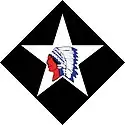 6th Marine Regiment
6th Marine Regiment- Colonel Gilder D. Jackson Jr.[lower-alpha 18]
- Exec. ofc.: Lt. Col. Alfred A. Watters (to 15 Dec); Lt. Col. Lyman G. Miller
- 1st Battalion: Lt. Col. Russell Lloyd
- 2nd Battalion: Maj. Raymond L. Murray
- 3rd Battalion: Maj. William A. Kengla
 8th Marine Regiment
8th Marine Regiment- Colonel Richard H. Jeschke
- Exec. ofc.: Lt. Col. James P. Riseley
- 1st Battalion: Lt. Col. Miles S. Newton (from 15 Jan. to 15 Nov, 1942); Maj. Joseph B. McCaffery
- 2nd Battalion: Lt. Col. John H. Cook Jr.
- 3rd Battalion: Lt. Col. Augustus H. Fricke
 10th Marine Regiment (Artillery)
10th Marine Regiment (Artillery)- Colonel Thomas E. Bourke
- Exec. ofc.: Lt. Col. Ralph E. Forsyth
- 1st Battalion: Lt. Col. Presley M. Rixey
- 2nd Battalion: Maj. George R. E. Shell
- 3rd Battalion: Lt. Col. Manly L. Curry (to 18 Oct; from 28 Nov); Lt. Col. Donovan D. Sult (18 Oct-28 Nov)
- 4th Battalion: Lt. Col. Kenneth A. Jorgensen

- Other Marine units
- 2nd Amphibian Tractor Battalion: Maj. Henry C. Drewes
- 9th Defense Battalion (landed December 1942)
- Commanding officer: Col. David R. Nimmer
- Executive officer: Lt. Col. William J. Scheyer
- Operations officer: Capt. William C. Givens
- 2nd Raider Battalion ("Carlson's Raiders"): Lt. Col. Evans F. Carlson
- 2nd Special Weapons Battalion: Lt. Col. Paul D. Sherman
- 2nd Tank Battalion: Maj. Alexander B. Swenceski
- 6th Naval Construction Battalion: Lt. Cmdr. Joseph L. Blundon, CEC[4] (Started landing on 27 August)
- 3rd Battalion 18th Marines (started landing on 12 December)[5]
Army forces
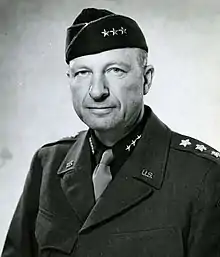
Major General Alexander M. Patch[lower-alpha 19]
- Arrived in echelons beginning 13 October:
- Landed 13 October:
- Landed 12 November:
- 147th Infantry Regiment (Separate) (Ohio National Guard)
- 97th Field Artillery Battalion
- 214th Coast Artillery (United States)
- 244th Coast Artillery Regiment
- 221st Field Artillery Battalion
- 245th Field Artillery Battalion
- 246th Field Artillery Battalion
- 247th Field Artillery Battalion
- 57th Engineer Combat Battalion

Major General J. Lawton Collins[lower-alpha 20]
- Arrived in echelons beginning 17 December:
- Battalion-level units:
- 8th Field Artillery Battalion
- 64th Field Artillery Battalion
- 89th Field Artillery Battalion
- 90th Field Artillery Battalion
- 65th Engineer Combat Battalion
Service Command, South Pacific Theater of Operations
Brigadier General Raymond E. S. Williamson
- 70th Coast Artillery
- Engineer units
- Supply units
- Military Police units
Japanese

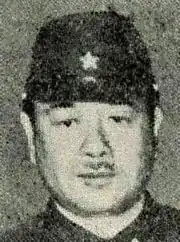
Seventeenth Army[lower-alpha 21]
Lieutenant General Harukichi Hyakutake[lower-alpha 22][6]
2nd Infantry (Sendai) Division
Lieutenant General Masao Maruyama
- Landed between 5 September and 4 October:
- 4th Infantry Regiment
- 16th Infantry Regiment
- 29th Infantry Regiment
- 2nd Artillery Regiment
- 2nd Engineer Battalion
38th Infantry Division
Lieutenant General Tadayoshi Sano
- The depleted 38th Division landed 5–15 November
- 228th Infantry Regiment
- 229th Infantry Regiment
- 230th Infantry Regiment
- 38th Mountain Gun Regiment
- 38th Engineer Battalion
35th Brigade
Major General Kiyotaki Kawaguchi[lower-alpha 23]
- Landed 29 August–5 September; included a late-arriving battalion of the 28th Infantry Regiment.
- 124th Infantry Regiment
- Kitao Battalion / Ichiki Detachment[lower-alpha 24]
- 4th Artillery Regiment
- 10th Mountain Gun Battalion
- 20th Mountain Gun Battalion
Other units
- 28th Infantry Regiment
- Arrived 6 July to begin construction of an airstrip:
- 11th Construction Unit
- 13th Construction Unit
Notes
- ↑ Awarded Congressional Medal of Honor 5 Feb 1943; made 18th Commandant of the Marine Corps 1 Jan 1944; promoted to four-star general 21 Mar 1945.
- ↑ Commanded division on Peleliu.
- ↑ Relieved by Vandegrift for poor performance
- ↑ Commanded the division in Korea
- ↑ Killed when a patrol he had organized encountered unexpected Japanese resistance and was essentially wiped out.
- ↑ Commanded 4th Marine Division on Iwo Jima
- ↑ Relieved by Vandegrift for poor performance; never held another combat command, but was promoted to major general and commanded the 2nd Marine Division after the war.
- ↑ International News Service correspondent Richard Tregaskis, whose best-selling Guadalcanal Diary related his experiences during the first seven weeks of the campaign, was attached to this headquarters.
- ↑ Later commanded Fleet Marine Force, Pacific
- ↑ Relieved for perceived lack of aggressiveness.
- ↑ Relieved by Vandegrift for poor performance.
- ↑ Eventually became most-decorated man in history of Marine Corps.
- ↑ Commanded 7th Marines on Peleliu.
- ↑ Promoted to Brigadier General 9 Oct; commanded 1st Marine Division during Okinawa Campaign.
- ↑ Commanded 15th Marines during Okinawa Campaign.
- ↑ Later rose to regimental and assistant division command
- ↑ Also commanded the battalion on Tarawa, Saipan and Tinian
- ↑ Malaria acquired on Guadalcanal having rendered him unfit for further frontline duty, he received only stateside assignments afterward.
- ↑ Later rose to army command during the liberation of Europe
- ↑ Later rose to Corps command during the liberation of Europe and Army Chief of Staff during Korean War
- ↑ A Japanese army was equivalent to a Euro-American corps.
- ↑ Arrived on the island to take direct command 10 October.
- ↑ Relieved 23 October and given rear-area command after repeated refusal to obey orders
- ↑ Arrived 18–24 August.
References
Bibliography
- Morison, Samuel Eliot (1949). Coral Sea, Midway and Submarine Actions, May 1942 – August 1942. History of United States Naval Operations in World War II. Vol. IV. Boston: Little, Brown and Co.
- Morison, Samuel Eliot (1948). The Struggle for Guadalcanal, August 1942 – February 1943. History of United States Naval Operations in World War II. Vol. V. Boston: Little, Brown and Co.
- Stille, Mark (2015). Guadalcanal, 1942–43: America's first victory on the road to Tokyo. Oxford: Osprey.